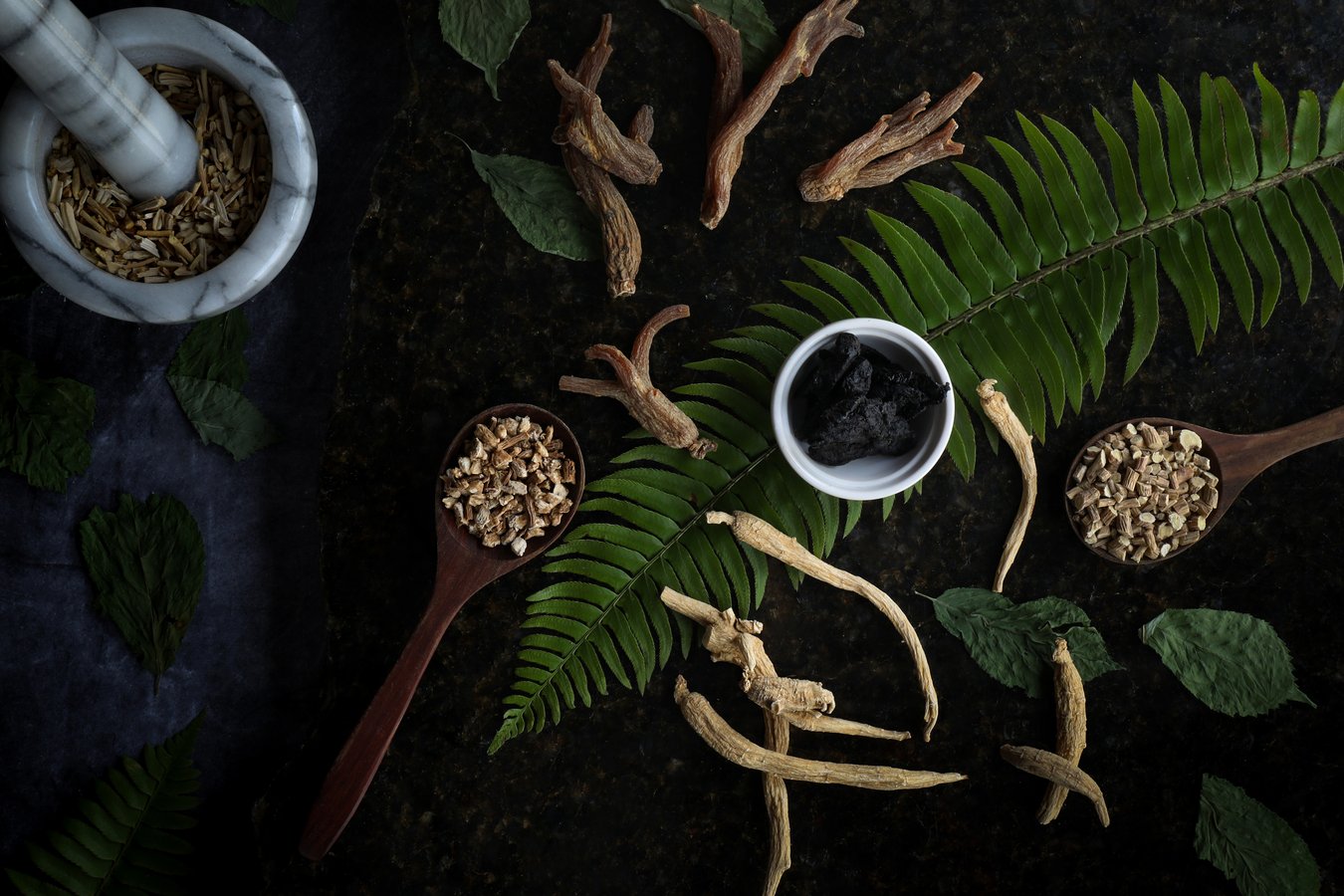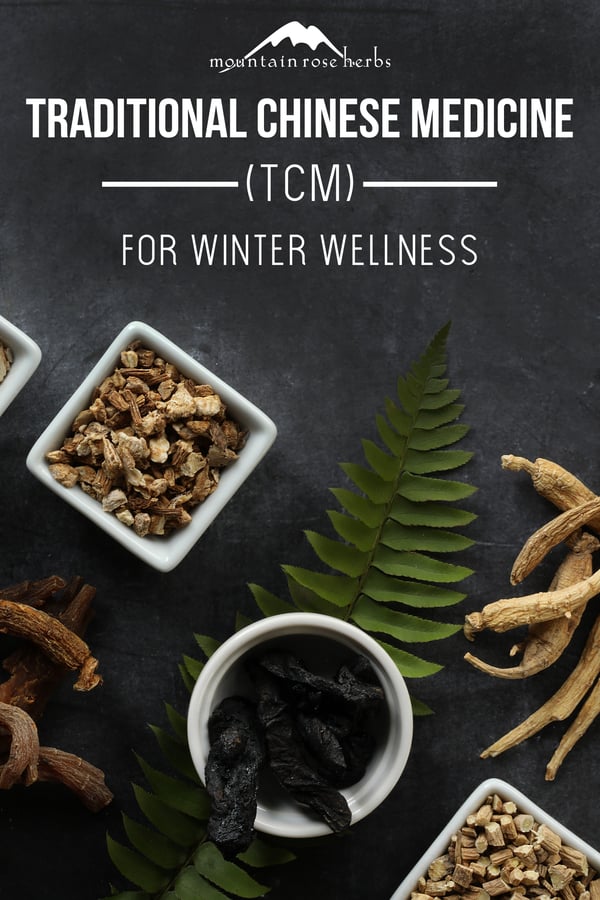
In Traditional Chinese Medicine’s (TCM) Five Element theory, water is the element of winter and it governs the kidney and bladder meridian channels. Welcome to the north, place of coldness, the Great Mystery, that liminal place between birth and death, hibernation, and gentle yet powerful underground transformation. Miles and miles of infinite expansive water flows, seen and unseen, across the planet. 60% of our bodies are water.
Qi, Blood, and Yin tonics can all be sweet, and tend towards a rich or heavy nature. These herbs are commonly paired with digestive herbs, such as ginger. However, tonics should only be taken on an as-needed, clinically appropriate basis, and are contraindicated for sluggish digestion, as well as excess type conditions such as acute disease, fevers, inflammation, or obesity.
Most of these tonifying botanicals are roots, best prepared in decoctions or as powders or granules.
Qi Tonics
Qi vitalizes our bodies, powering the physiological functions of organs and meridians, including development, growth, and blood formation. Qi keeps the body warm, defends the body from disease, holds everything in its proper place, and facilitates elegant movement and transformation. Qi deficiency can cause fatigue, weakness, lack of appetite, shortness of breath, and more. Qi tonics are usually sweet and rich. Overuse can lead to fullness, heat, or other stagnation.
Ginseng root (Panax ginseng, Araliaceae. Renshen, 人參) is revered for its immune-boosting and adaptogenic qualities. Asian ginseng is native to the mountains of China and Korea and is considered more stimulating than American ginseng (Panax quinquefolius). It’s warming and moistening, and often taken by older, cold, pale, and easily tired people. Due to the increasing costs and precious nature of ginseng, Chinese herbalists often substitute ginseng with 2-3 times as much codonopsis, taken as a decoction.
Codonopsis root (Codonopsis pilosula, Campanulaceae. Dang shen, 黨參) is a gentle Qi tonic and adaptogen. Native to Asia, codonopsis has twining stems with bell-shaped flowers and carrot-shaped roots, and is typically prepared as a decoction or extract. Neutral, moistening, and nourishing, codonopsis is a safer, cheaper, and more easily accessible alternative to ginseng.
Astragalus root (Astragalus membranaceus, Fabaceae. Huang qi, 黃芪) is a sun-loving perennial native to China, Mongolia, and North Korea. It’s a slightly warming and moistening Qi-tonic and adaptogen that can be tinctured, decocted, and simmered into delicious soups, stews, and broths. Codonopsis and astragalus both have an affinity with the lungs, and are quite tasty combined with other herbs and vegetables in tonic-stews.
Blood Tonics
Chinese medicine’s blood comes from food and our innate constitution. Blood nourishes organs, tissues, and meridians. Blood maintains healthy bodily movement and sensation, as well as mental health. Blood deficiency can lead to pallor, dizziness, vertigo, lethargy, dry skin, menstrual irregularities, weakness, and a fine pulse. Blood tonification herbs are typically combined with Qi tonics or Yin tonics, depending on what is causing the Blood deficiency. Most of these herbs can be cloying, so are typically partnered with digestive herbs.
Rehmannia root (Rehmannia glutinosa, Orobanchaceae. Sheng di huang 生地黃 . Shu di huang 熟地黃) nourishes the Yin, or the body’s underlying infrastructures. Sheng di huang is raw rehmannia. It is sweet, bitter, and cold. Shu di huang is prepared rehmannia. It is sweet, warm, moist, and richly tonifying, so should not be taken with digestive or qi stagnation. Prepared rehmannia is more tonifying than raw rehmannia. Take as a decoction, usually within a formula.
He shou wu root (Polygonum multiflorum, Polygonaceae. 何首烏) is a flowering vine with a woody tuber that is native to China. Also known as Fo-Ti Root, it is neutral and moistening, and energetically nourishes the heart and calms the spirit. Take as a decoction or tincture.
Dong Quai root (Angelica sinensis, Fabaceae. Dang gui, 當歸) nourishes and moves the blood. Dong Quai is a small perennial, growing up to three feet in height. It is native to high altitude regions of China and Japan, and grows best in cold, damp areas. “Dong quai" literally translates to "state of return."
Yang Tonics
Chinese medicine is a holistic system of checks and balances. Each element both generates and holds other elements in check. Yang governs the outward, warm, active, and excitatory body systems, whereas Yin governs the inward, cooling, resting, and inhibitory systems. Healthy yang is integral for qi-transforming. The kidney organ system forms the basis of the body’s Yang. Kidney yang deficiency may create systemic exhaustion or coldness. Most Yang tonics are warm and drying, which can injure the Yin over time. Many yang tonics involve animal products and are not included in this article.
Cordyceps fungus (Cordyceps spp., Cordycipitaceae. Dong chong xia cao, 冬蟲夏草) gets its name from Greek and Latin words meaning “club” and “head”. There are approximately 400 species of cordyceps, most of which are abundant in tropical climates. The cordyceps fungus parasitizes insects and occasionally other fungi to propagate. It is a slightly warming adaptogen, often used to improve athletic performance and stamina.
Yin Tonics
Yin is the nourishing principle of our bodies, cultivated through rest and stillness. Yin deficiency may lead to a sense of heat, also known as “deficient heat,” such as anxiety, fever, night sweats, constipation, or physical dryness. Yin tonics are often sweet, cold, enriching, and moistening. They can be heavy, so are usually supported by digestive herbs to prevent stasis.
Shatavari root (Asparagus racemosus, Asparagaceae. Tian men dong, 天門冬) tonifies Yin for lung and kidney organ systems, generates fluids, and cools deficient heat. Translating to “hundred husbands” in Hindi, shatavari root has been used as a tonic for the female system in Ayurvedic practices for centuries. Chinese and Indian medicine utilize the same genus Asparagus, but different species of this plant. Chinese medicine mostly uses A. cochinchinensis, whereas Ayurvedic medicine utilizes A. racemosus. They are used for similar purposes, with similar properties. The plant has small, uniform green leaves, tiny white flowers, and numerous tuberous roots. Shatavari can be ingested as a decoction or powder. Mix shatavari powder into molasses and honey to create a nourishing tonic paste.
Black sesame seeds (Sesamum indicum, Pedaliaceae. Hei zhi ma, 黑芝麻) tonifiy the liver and kidney Chinese medicine organ systems, and augments Yin and blood. Due to the oily nature of seeds, seeds are often used to “lubricate the intestines” in Chinese medicine. Incorporate black sesame into cooking, take sesame paste, or eat lightly sweetened sesame candy.
American ginseng root (Panax quinquefolius, Araliaceae. Xi yang shen, 西洋參) grows in specialized woodland habitats throughout eastern North America. American ginseng is currently experiencing population decline due to its popularity, over harvesting, poaching, and habitat loss (though the one carried by Mountain Rose Herbs is forest farmed.) Cooling and moistening, it can support adrenals as an adaptogenic decoction.
(For more information and inspiration from the author, visit JilingLin.com.)
Looking for More from Jiling?
Read Her Other Seasonally-Inspired TCM posts!
You might also enjoy:
*This statement has not been evaluated by the Food and Drug Administration. This product is not intended to diagnose, treat, cure, or prevent any disease. For educational purposes only












